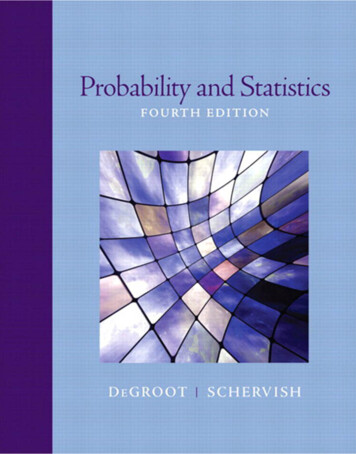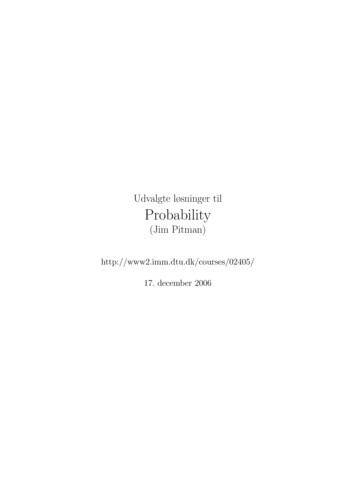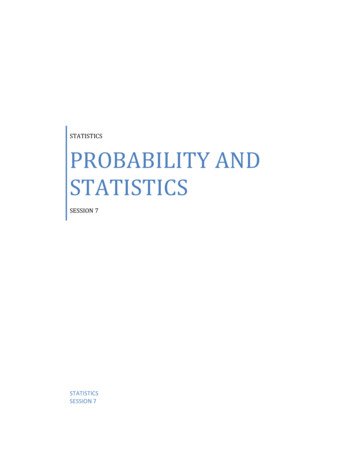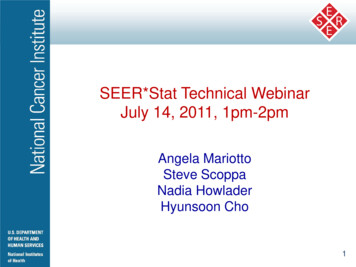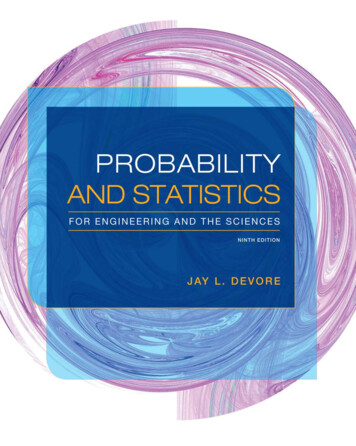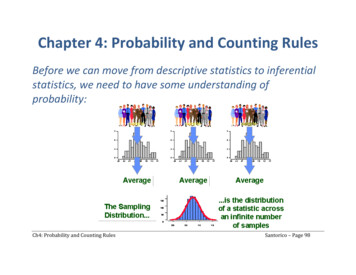
Transcription
Chapter 4: Probability and Counting RulesBefore we can move from descriptive statistics to inferentialstatistics, we need to have some understanding ofprobability:Ch4: Probability and Counting RulesSantorico – Page 98
Section 4-1: Sample Spaces and ProbabilityProbability - the likelihood of an event occurring.Probability experiment – a chance process that leads to welldefined results called outcomes. (i.e., some mechanism thatproduces a set of outcomes in a random way).Outcome – the result of a single trial of a probabilityexperiment.Example: Roll a die once. What could happen in one roll ofthe die?Ch4: Probability and Counting RulesSantorico – Page 99
Sample space – the set of all possible outcomes of aprobability experiment.Example: What is the sample space for one flip of a coin?Heads, TailsExample: Suppose I roll two six-sided dice. What is thesample space for the possible outcomes?1, 2, 3, 4, 5, 6Ch4: Probability and Counting RulesSantorico – Page 100
Example: Find the sample space for drawing one cardfrom an ordinary deck of cards.Sample space consists of all possible 13x4 52 outcomes:A , 2 , ,K , , A , 2 , ,K Ch4: Probability and Counting RulesSantorico – Page 101
TREE DIAGRAM – a device consisting of line segmentsemanating from a starting point and also from theoutcome points. It is used to determine all possibleoutcomes of a probability experiment.Example: Use a tree diagram to find the sample space for the sex ofthree children in a family.Our outcome pertains to the sex of one child AND the second of thenext child AND the sex of the third child. Each of the children willcorrespond to a branching in the tree. What is the sex of the first child? Boy/Girl Given the sex of the first child, what is the sex of the secondchild? Given the sex of the first two children, what is the sex of the thirdchild?Ch4: Probability and Counting RulesSantorico – Page 102
Ch4: Probability and Counting RulesSantorico – Page 103
Example: 3 pairs of jeans, 5 shirts, 2 hats. Use a tree diagramto determine all possible outfits composed of a pair of jeans,shirt, and a hat.Ch4: Probability and Counting RulesSantorico – Page 104
Event – consists of a set of possible outcomes of a probabilityexperiment. Can be one outcome or more than one outcome. Simple event – an event with one outcome. Compound event – an event with more than oneoutcome.Example: Roll a die and get a 6 (simple event).Example: Roll a die and get an even number (compoundevent).Ch4: Probability and Counting RulesSantorico – Page 105
There are three basic interpretations or probability:1. Classical probability2. Experimental or relative frequency probability3. Subjective probabilityTheoretical (Classical) Probability – uses sample spaces todetermine the numerical probability that an event will happen. We do not actually perform the experiment to determinethe theoretical probability. Assumes that all outcomes are equally likely to occur.Ch4: Probability and Counting RulesSantorico – Page 106
Formula for Classic ProbabilityThe probability of an event E isNumber of outcomes in En(E)P(E) Number of outcomes in the sample space n(S) where S denotes the sample space and n( ) means “the numberof outcomes in . . . ”Rounding Rules for Probabilities – probabilities should be or rounded to 2-3 decimalexpressed as reduced fractionsplaces. If the probability is extremely small then round to thefirst nonzero digit.Ch4: Probability and Counting RulesSantorico – Page 107
Example: Consider a standard deck of 52 cards:Find the probability of selecting a queenCAN LEAVE AS AREDUCED FRACTION!41P queen 0.07752 13This is to demonstraterounding.Find the probability of selecting a spade, P(spade) Find the probability of selecting a red ace, P(red ace) Ch4: Probability and Counting RulesSantorico – Page 108
Probability Rules1. The Probability of an event E must be a number between 0and 1. i.e., 0 P(E) 1.2. If an event E cannot occur, then its probability is 0.3. If an event E must occur, then its probability is 1.4. The sum of all probabilities of all the outcomes in thesample space is 1.Always a good“sanity check” whendoing calculations!Ch4: Probability and Counting RulesSantorico – Page 109
Example: Suppose I roll a standard six-sided die.What’s the probability I get a 7?What’s the probability that I get a number less than 7?What’s the probability that I get a 1 or a 2 or a 3 or a 4 or a 5 ora 6?Ch4: Probability and Counting RulesSantorico – Page 110
Complementary EventsComplement of an event E - the set of outcomes in the samplespace that are not included in the outcomes of event E. Thecomplement of E is denoted by E (“E bar”).Note: The outcomes of an event and the outcomes of thecomplement make up the entire sample space.Ch4: Probability and Counting RulesSantorico – Page 111
Venn Diagram – a visual way of representing probabilities.Venn diagrams are a wonderful tool to help think throughprobability calculations.Ch4: Probability and Counting RulesSantorico – Page 112
Example: What is the complement of the following events?Rolling a six-sided die and getting a 4?Complement Rolling a die and getting 1 ,2, 3, 5 or 6.Rolling a die and getting a multiple of 3?Selecting a day of the week and getting a weekday?Selecting a month and getting a month that begins with an A?Ch4: Probability and Counting RulesSantorico – Page 113
Rule for Complementary Events:P(E) 1 P(E) or P(E) 1 P(E) or P(E) P(E ) 1. Example: The probability of purchasing a defective light bulb is12%. What is the probability of not purchasing a defective light bulb? P(not defective) 1 – P(defective) 1-0.12 0.88Example: What is the probability of not selecting a club in astandard deck of 52 cards?Ch4: Probability and Counting RulesSantorico – Page 114
Empirical Probability – the relative frequency of an eventoccurring from a probability experiment over the long-run. It relies on actual experience to determine the likelihoodof an outcome rather than assuming equally likelyoutcomes.Given a frequency distribution, the probability of an eventbeing in a given class is:frequency for the classfP(E) .total frequencies in the distribution nThis probability is called the empirical probability. Ch4: Probability and Counting RulesSantorico – Page 115
Example: Observe the proportion of male babies out of many,many births.Example: Major Field of What is the probability of being a math major? Science major?History or English Major?P(M) 5/25 0.2Ch4: Probability and Counting RulesP(S) P(H or E) Santorico – Page 116
The Law of Large Numbers tells us that the as the number oftrials increases the empirical probability gets closer to thetheoretical (true) probability.Because of the law of large numbers we will interpret theprobability to be the “long-run” results (which we knowapproximates the theoretical probability).The probability of a particular outcome is the proportion oftimes the outcome would occur in a long-run of observations.Ch4: Probability and Counting RulesSantorico – Page 117
Example: Proportion of times a fair coin comes up as a “head”Ch4: Probability and Counting RulesSantorico – Page 118
Subjective Probability – uses a probability value based on aneducated guess or estimate, employing opinions and inexactinformation. Often, you cannot “repeat” the probability experiment.Example: What is the probability you will pass this class?Example: What is the probability that you will get a certain jobwhen you apply?Read about Probability and Risk Taking on pg. 194-195. We arenotoriously bad at subjectively estimating probability!Ch4: Probability and Counting RulesSantorico – Page 119
SECTION 4-2: THE ADDITION RULES FOR PROBABILITYThere are times when we want to find the probability of two or moreevents. For example, when selecting a card from a deck we maywant to find the probability of selecting a card that is a four or red.In this case there are 3 possibilities to consider: The card is a four The card is red The card is a four and redNow consider selecting a card and we want to find the probability ofselecting a card that is a spade or a diamond. In this case there areonly 2 possibilities to consider: The card is a spade The card is a diamondNotice it can’t be both a spade and a diamond.Ch4: Probability and Counting RulesSantorico – Page 120
Mutually exclusive - Two events are mutually exclusive (disjoint) ifthey cannot occur at the same time.Looking ahead: If we have mutually exclusive events, then their probabilities will add.Let’s make sure we understand what it means for events to be mutually exclusive.Example:Which events are mutually exclusive and which are not, when asingle die is rolled?1. Getting an odd number and getting an even numberMutually exclusive! You can’t have a roll be both.2. Getting a 3 and getting an odd number3. Getting an odd number and getting a number less than 44. Getting a number greater than 4 and getting a number lessthan 4Ch4: Probability and Counting RulesSantorico – Page 121
Intersection – the intersection of events A and B are theoutcomes that are in both A and B. If A and B have outcomesintersecting each other than we say that they are nonmutually exclusive.Union – the union of events A and B are all the outcomes thatare in A, B, or both.Ch4: Probability and Counting RulesSantorico – Page 122
Example: Suppose we roll a six-sided die. Let A be that we rollan even number. Let B be that we roll a number greater than 3.ABABABWhat is the intersection between A and B?Rolling a 6 or 4What is the union of A and B?Rolling a 6, 5, 4, or 2Ch4: Probability and Counting RulesSantorico – Page 123
Addition Rules (These apply to “or” statements.)Rule 1: If two events A and B are mutually exclusive, then:P(A or B) P(A) P(B)Rule 2: For ANY two outcomes A and B,P(A or B) P(A) P(B) – P(A and B)Note: In probability “A or B” denotes that A occurs, or B occurs,or both occur!Ch4: Probability and Counting RulesSantorico – Page 124
Venn diagrams for mutually versus non-mutuallyexclusive events:Ch4: Probability and Counting RulesSantorico – Page 125
Example: At a political rally, there are 20 Republicans, 13Democrats, and 6 Independents. If a person is selected at random,find the probability that he or she is either a Democrat or anIndependent.Event A a person is a democratEvent B a person is an independentThese are mutually exclusive since you can NOT be both.P a person is a Democrat or an Independent P A or B P A P B 136 20 13 6 20 13 613 6 39 3919 0.48739 Ch4: Probability and Counting RulesSantorico – Page 126
Example: A single card is drawn at random from an ordinary deckof cards. Find the probability that the card is either an ace or a redcard. (Hint: Define events. Determine if mutually exclusive. Useappropriate rule on slide 28.)Ch4: Probability and Counting RulesSantorico – Page 127
Example: On New Year’s Eve, the probability of a person drivingwhile intoxicated is 0.32, the probability of a person having a drivingaccident is 0.09, and the probability of a person having a drivingaccident while intoxicated is 0.06. What is the probability of aperson driving while intoxicated or having a driving accident?Ch4: Probability and Counting RulesSantorico – Page 128
Section 4-3 The Multiplication Rulesand Conditional ProbabilityThe multiplication rules can be used to find the probabilities oftwo or more events that occur in sequence. When there are multiple stages in the experiment When there are 2 or more trials For example, tossing a coin then rolling a die (a 2-stageexperiment)Multiplication rules apply to “and” statements.Ch4: Probability and Counting RulesSantorico – Page 129
Independent - two events A and B are independent events ifthe fact that A occurs does not affect the probability of Boccurring.Example: Rolling one die and getting a six, rolling a second dieand getting a three.Example: Draw a card from a deck and replacing it, drawing asecond card from the deck and getting a queen.In each example, the first event has no effect on the probability ofthe second event.Ch4: Probability and Counting RulesSantorico – Page 130
Multiplication Rule for Independent EventsMultiplication Rule 1: When two events A and B are independent,then P(A and B) P(A)P(B)That is, when events are independent, their probabilities multiplyin an “and” statement. Example: The New York state lottery uses balls numbered 0-9circulating in 3 separation bins. To select the winning sequence, oneball is chosen at random from each bin. What is the probability thatthe sequence 9-1-1 would be the one selected?1 1 11P(Sequence 9 1 1) 0.00110 10 10 1000Actually, this is the same probability of any of the equally likely 1000drawsCh4: Probability and Counting RulesSantorico – Page 131
Example: Approximately 9% of men have a type of color blindnessthat prevents them from distinguishing between red and green. If 3men are selected at random, find the probability that all of them willhave this type of red-green color blindness.Ch4: Probability and Counting RulesSantorico – Page 132
Dependent - Two outcomes are said to be dependent ifknowing that one of the outcomes has occurred affects theprobability that the other occurs.Examples: Drawing a card from a deck, not replacing it, and thendrawing a second card. Being a lifeguard and getting a suntan Having high grades and getting a scholarship Parking in a no-parking zone and getting a ticketCh4: Probability and Counting RulesSantorico – Page 133
The Conditional Probability of an event B in relationship toan event A is the probability that event B occurs after event Ahas already occurred. This probability is denoted as P(B A).When events are dependent we cannot use the current form ofthe multiplication rule. We have to modify it. Ch4: Probability and Counting RulesSantorico – Page 134
Multiplication Rule for Dependent EventsMultiplication Rule 2: When two events are dependent, theprobability of both occurring is P(A and B) P(A)P(B A).Example: What is the probability of getting an Ace on the firstdraw and a king on a second draw? P(Ace then King) P(Ace) P(King Ace)4 4 0.00652 51First draw from fulldeck of 52 cards has 4AcesSecond draw from a deck of51 cards (which is missing asingle Ace) has 4 KingsCh4: Probability and Counting RulesSantorico – Page 135
Example: At a university in western Pennsylvania, there were5 burglaries reported in 2003, 16 in 2004, and 32 in 2005. If aresearcher wishes to select two burglaries at random tofurther investigate, find the probability that both will haveoccurred in 2004?Ch4: Probability and Counting RulesSantorico – Page 136
Example: World Wide Insurance Company found that 53% ofthe residents of a city had homeowner’s insurance (H) with thecompany. Of these clients, 27% also had automobile insurance(A) with the company. If a resident is selected at random, findthe probability that the resident has both homeowner’sinsurance and automobile insurance with World WideInsurance Company.P( H and A) P( H ) P( A H ) 0.53 0.27 0.1431Ch4: Probability and Counting RulesSantorico – Page 137
Formula for Conditional ProbabilityThe probability that the second event B occurs given that thefirst event A has occurred can be found by dividing theprobability that both events have occurred by the probabilitythat the first event has occurred. For events A and B, theconditional probability of event B given A occurred isP(B A) P(A and B)P(A) Ch4: Probability and Counting RulesSantorico – Page 138
Example: A box contains black chips and white chips. A personselects two chips without replacement. If the probability of selectinga black chip and a white chip is 15/56, and the probability ofselecting a black chip in the first draw is 3/8, find the probability ofselecting the white chip on the second draw, given that the first chipselected was a black chip.Want to compute: P(White chip on second draw First chip was black)Know: P(Selecting black and white chip) 15/56P(Selecting black chip on first draw) 3/8Applying formula for conditional probability:P(White chip on second draw First chip was black)P(Selecting black and white chip) 15 / 56 0.714P(First chip was black)3/8Ch4: Probability and Counting RulesSantorico – Page 139
Example: The probability that Sam parks in a no-parking zoneand gets a parking ticket is 0.09. The probability that Samcannot find a legal parking space and has to park in the noparking zone is 0.20. Today, Sam arrived at UCD and has topark in a no-parking zone. Find the probability that he will geta parking ticket.Let N parking in a no-parking zone, T getting a ticketCh4: Probability and Counting RulesSantorico – Page 140
Venn Diagram for Conditional ProbabilityCh4: Probability and Counting RulesSantorico – Page 141
Probabilities for “At Least”The multiplication rules can be coupled with thecomplimentary event rules (Section 4-1) to solve probabilityproblems involving “at least”.Example: A game is played by drawing 4 cards from anordinary deck and replacing each card after it is drawn. Findthe probability that at least 1 ace is drawn.P at least 1 Ace 1– P no aces drawn Complementation48 48 48 48 52 52 52 52 1 0.726025 0.274Multiplication Rule 1 Ch4: Probability and Counting RulesNote rounding to 3 decimalplaces.Santorico – Page 142
What keyword in a probability problem probably means youshould use the additional rules?What keyword in a probability problem probably means youshould use the multiplication rules?Ch4: Probability and Counting RulesSantorico – Page 143
Example: Consider a system of four components, as pictured inthe diagram. Components 1 and 2 form a series subsystem, asdo Components 3 and 4. The two subsystems are connected inparallel. Suppose that P(1 works) .9, P(2 works) .9, P(3works) .9, P(4 works) .9, and that the four outcomes areindependent of each other.Ch4: Probability and Counting RulesSantorico – Page 144
The subsystem works only if both components work. What isthe probability the 1-2 subsystem works?What is the probability that the 1-2 subsystem doesn’t work?That the 3-4 subsystem doesn’t work?The system won’t work if both the 1-2 subsystem doesn’t workand the 3-4 subsystem doesn’t work. What is the probabilitythat it won’t work? That it will work?Ch4: Probability and Counting RulesSantorico – Page 145
Ch4: Probability and Counting RulesSantorico – Page 146
Ch4: Probability and Counting Rules Santorico - Page 105 Event - consists of a set of possible outcomes of a probability experiment. Can be one outcome or more than one outcome. Simple event - an event with one outcome. Compound event - an event with more than one outcome. Example: Roll a die and get a 6 (simple event).Example: Roll a die and get an even number (compound


